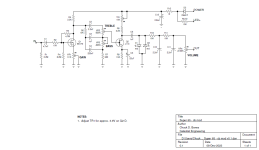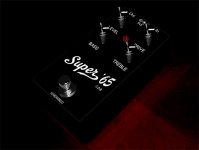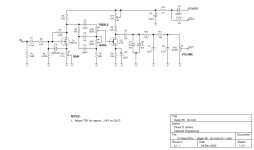Chuck D. Bones
Circuit Wizard
Phill suggested I check out this circuit. It's a Fender preamp emulator. I built it per the schematic you can find on the Internets, but found the tone to be less than satisfying. One of the things that goes wrong when emulating a tube amp with FETs is headroom. Unless you hit a tube amp with a boost or OD pedal, the first stage runs clean because it has at least 100V of headroom. No so with a FET running on 9V. Even 18V doesn't necessarily get you there. But... why not throttle the gain of the first stage so that we can make it run clean if we want? There will still be plenty of signal to overdrive the second stage. Here's what I ended up with:
Black knob: VOLUME - Green knob: GAIN - WHITE knob: TREBLE - Red knob: BASS


Plays nice with Humbuckers, P-90s and single coil pickups. This is a low-to-medium gain pedal. Will make some dirt and sustain, but not a huge amount. It's mainly for making some low-order harmonics, some EQ and boost. Because the LEDs limit the swing on Q2's drain, we can set the drain voltage lower than we usually would to get the best tone. J113 works very well here. So does MPF4393. A variety of JFETs will work, but make sure the Vp is above 1.5V because we don't want to overdrive Q2's gate. The first stage gain varies from 6dB to 30dB at 1KHz. The bass drops off a bit at higher GAIN settings, which keeps Q1 from getting muddy. The BASS knob can more than make up for any bass lost in C1. The second stage gain is 26dB at 1KHz. The tone stack loses up to 24dB depending on freq and knob settings. Maximum output is a little over 2Vp-p. Try it, you might like it!
Black knob: VOLUME - Green knob: GAIN - WHITE knob: TREBLE - Red knob: BASS


Plays nice with Humbuckers, P-90s and single coil pickups. This is a low-to-medium gain pedal. Will make some dirt and sustain, but not a huge amount. It's mainly for making some low-order harmonics, some EQ and boost. Because the LEDs limit the swing on Q2's drain, we can set the drain voltage lower than we usually would to get the best tone. J113 works very well here. So does MPF4393. A variety of JFETs will work, but make sure the Vp is above 1.5V because we don't want to overdrive Q2's gate. The first stage gain varies from 6dB to 30dB at 1KHz. The bass drops off a bit at higher GAIN settings, which keeps Q1 from getting muddy. The BASS knob can more than make up for any bass lost in C1. The second stage gain is 26dB at 1KHz. The tone stack loses up to 24dB depending on freq and knob settings. Maximum output is a little over 2Vp-p. Try it, you might like it!



